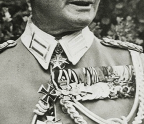

Just after dawn on July 14, 1918—Bastille Day in France—four American fliers of the 95th Aero Squadron, piloting French-built Nieuport 28 biplane fighters, set out on patrol looking for German observation aircraft. Shortly after crossing no-man’s-land, the flight encountered not lightly armed observation planes but seven Fokker D.VII biplane fighters. While the Nieuport 28 was a capable airframe, the Fokker D.VII proved one of the most formidable fighters of the war. In this encounter the Germans had not only more and better aircraft, but also the advantages of altitude and the sun at their backs on this partly cloudy day. Recognizing the predicament, the American flight leader tried to get his formation back across no-man’sland. Before the Nieuports could reach friendly airspace, however, the faster Fokkers caught up. Within moments the Germans broke up the American formation, and the encounter devolved into a free-for-all dogfight. After the war 1st Lt. Edward Buford Jr., a pilot of the 95th, recalled having spotted one of his flight’s Nieuports with three Fokkers in pursuit. Buford turned to intervene, only to watch helplessly as moments later the fleeing Nieuport turtled and plunged toward the ground. Realizing there was little hope for his downed fellow American, the lieutenant turned back for base, dodging from cloud to cloud for fear of running into another German formation. At the time Buford had no idea who’d been piloting the downed plane. However, he was certain whoever it was had chosen to die fighting, as the American could have easily gotten away by flying into any of the patchy but numerous clouds.
and killed over France that morning in 1918 was Quentin Roosevelt, youngest son of former President Theodore Roosevelt. When killed, Quentin was just 20 years old and






